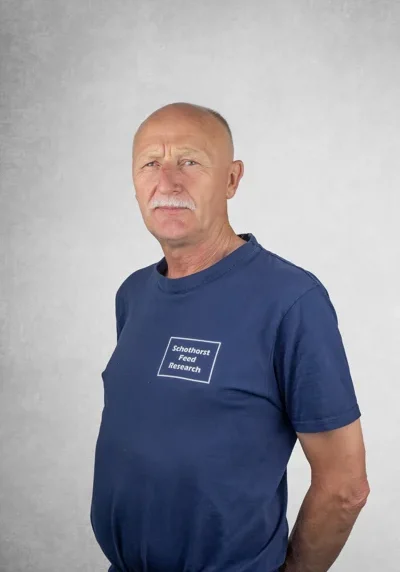Jaap Rozendaal
Jaap started at Schothorst Feed Research in August 1982 as a pig caretaker, right after attending gricultural school. “In my first year, I also had the opportunity to explore other animal species, which gave me a good understanding of the entire operation,” he says. Schothorst is a research company, which makes the work slightly different compared to a regular livestock farm. Jaap still regularly helps with research involving cattle and poultry. “It’s great how well everyone works together here, and how we support each other during busy research periods. It also adds variety to the work,” he says with satisfaction.
Collaboration makes it enjoyable
Jaap grew up in Putten on his family’s farm with cows and pigs, and he still commutes to Lelystad every day.
He was also involved in creating research feeds. “These feeds must meet the client’s exact requirements,” he explains. That’s why Schothorst collaborates with a trial feed factory that offers flexible production options.
Over time, Jaap returned full-time to working in the barn. Over the past few decades, he has witnessed many changes: “The work has become less physically demanding. In the early years, we had to carry a lot of straw and feed bags. Weighing piglets was also heavy work, but now everything is mechanized and automated, which makes things much easier.”
Due to new regulations in livestock farming, a lot has changed, especially in housing. Jaap explains, “Our sows now roam freely in the farrowing pens, and we stopped tail docking piglets and beak trimming hens years ago.” Such transitions require thorough research. “We need to carefully examine the impact on feed compositions, for example, with free-roaming sows or preventing feather pecking and cannibalism in hens.”
The staff has also grown significantly since Jaap started, from around forty to about a hundred employees. “We now have more international colleagues. Sometimes communication can be challenging for the barn staff, but we always manage to make it work with gestures. It’s great that management encourages foreign researchers to learn Dutch.”
There have been many upgrades to the facilities too, from new barns to a refreshed canteen.
“Collaboration here is always strong,” says Jaap. “I can easily walk into the lab or speak with the researchers for a quick discussion. And there’s real attention for each other, which creates a positive work atmosphere and a good balance between work and home life.” That culture allows everyone at Schothorst to “grow and thrive,” Jaap concludes with a smile.
